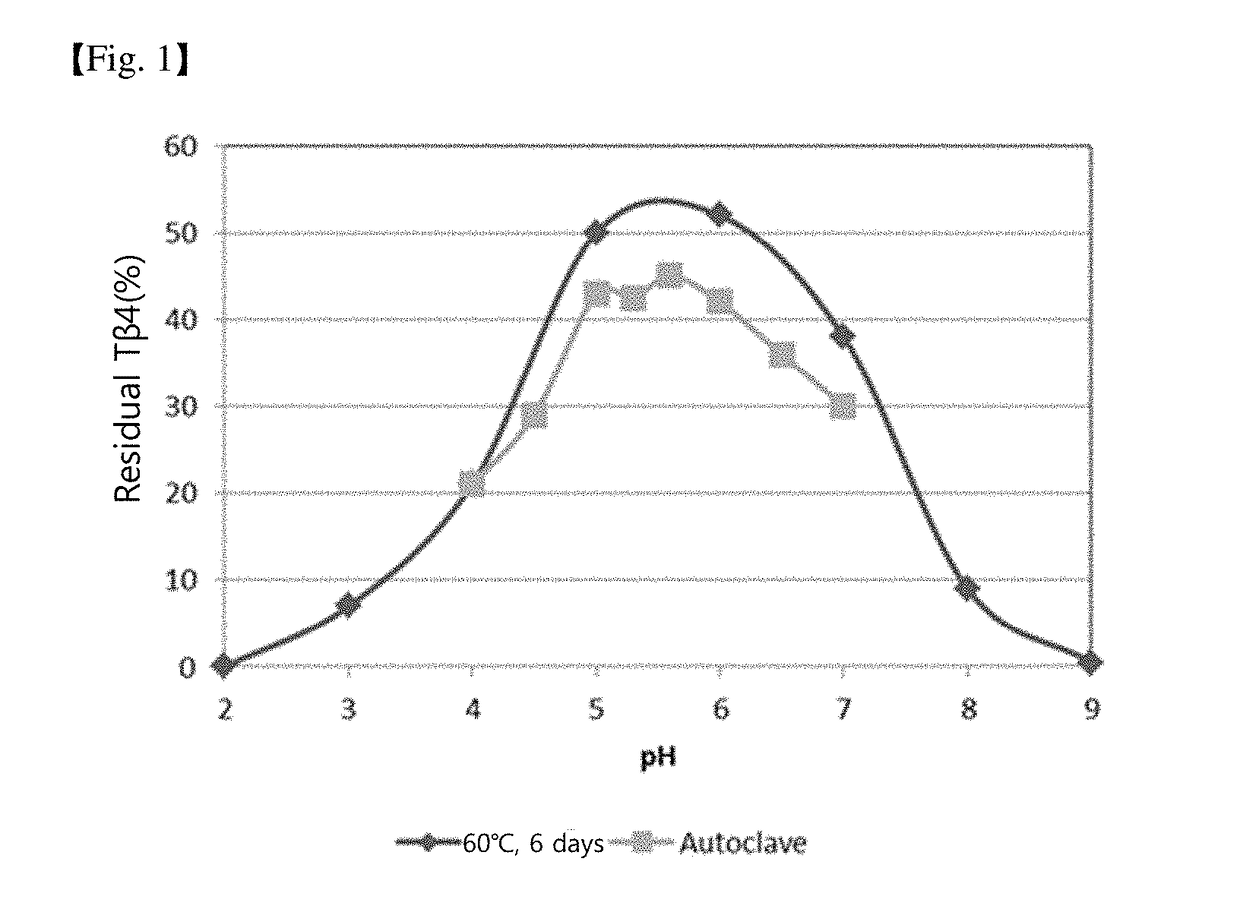Stabilized external preparation comprising thymosin beta 4 as an active ingredient
a technology of thymosin beta 4 and stabilized external preparation, which is applied in the direction of peptide/protein ingredients, pharmaceutical delivery mechanisms, inorganic non-active ingredients, etc., can solve the problems of hindering the preparation of pharmaceutical formulations, reducing its biological activity and therapeutic effects, etc., and achieves the effect of minimizing the generation of t4 sulfoxid
- Summary
- Abstract
- Description
- Claims
- Application Information
AI Technical Summary
Benefits of technology
Problems solved by technology
Method used
Image
Examples
experimental example 1
ability Depending on pH
[0048]The experiments for the confirmation of stability depending on pH were carried out over 6 days at 60° C. For pH values 2, 3, 6, 7, and 8, phosphate was used as a 50 mM buffer. For pH 4 and 5, acetate was used, while sodium bicarbonate was used for pH 9. Samples were prepared so that approximately 0.2 mg / mL of Tβ4 could be included in each buffer, and some were autoclaved. Residual Tβ4 was measured in each sample, and the results are shown in FIG. 1. As shown in FIG. 1, it can be found that the pH range where Tβ4 stability is best is from pH 5 to 6.
experimental example 2
ility Depending on the Kind of Buffer
[0049]Tβ4 was dissolved in each of the 30 mM buffers indicated in Table 1 below in a concentration of 1 mg / ml, then stored for 1 week at 40° C. Then reverse phase HPLC was employed to measure changes in Tβ4 content and the total amount of the peaks for impurities. Tβ4 content was measured by comparing the peak areas of the initial sample and the sample stored at 40° C. for 7 days with the peak area of the standard, and the rate of reduction was shown as a percentage (%) of (initial content−content after 1 week)÷ initial content.
[0050]Tβ4 oxides (methionine oxidized compound) were measured by comparing the peak area of the methionine oxides based on all peak areas shown during the HPLC analysis as a percentage (%). The rate of increase was shown as the ratio of (area for oxides after 1 week in %−initial area for oxides in %)÷ initial area for oxides in %.
[0051]Total impurities were measured by comparing the area of the peaks excluding that for Tβ4...
experimental example 3
ility Depending on the Kind of Additive
[0053]Tβ4 was dissolved in 10 mM phosphate buffer at pH 5.5 in a concentration of 1 mg / ml, and then additives with the contents indicated in Table 2 were dissolved therein. Impurities of the initial state (day 0) in each solution were measured using reverse phase HPLC, and the impurities of each solution stored for 1 week at 40° C. were then measured using reverse phase HPLC.
[0054]The additives were employed with the lowest possible concentration in the range of concentrations generally used for external preparations to investigate the influence on Tβ4 at the lowest additive concentration.
[0055]Total impurities were measured by comparing the area of the peaks excluding that for Tβ4 based on all peak areas shown during the HPLC analysis as a percentage (%). The rate of increase was shown as the ratio of (area for total impurities after 1 week in %−initial area for total impurities in %)÷ initial area for total impurities in %.
TABLE 2Oxides(Methi...
PUM
| Property | Measurement | Unit |
|---|---|---|
| concentration | aaaaa | aaaaa |
| concentration | aaaaa | aaaaa |
| concentration | aaaaa | aaaaa |
Abstract
Description
Claims
Application Information
 Login to View More
Login to View More - R&D
- Intellectual Property
- Life Sciences
- Materials
- Tech Scout
- Unparalleled Data Quality
- Higher Quality Content
- 60% Fewer Hallucinations
Browse by: Latest US Patents, China's latest patents, Technical Efficacy Thesaurus, Application Domain, Technology Topic, Popular Technical Reports.
© 2025 PatSnap. All rights reserved.Legal|Privacy policy|Modern Slavery Act Transparency Statement|Sitemap|About US| Contact US: help@patsnap.com

